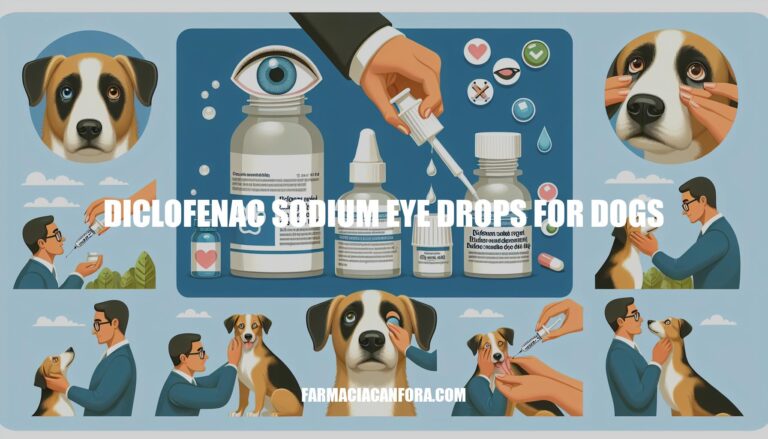Diclofenac sodium eye drops are a type of nonsteroidal anti-inflammatory drug (NSAID) used in veterinary medicine. Primarily, they help reduce inflammation and pain in dogs’ eyes, often prescribed for conditions like uveitis or post-surgery recovery.
Mechanism of Action
Diclofenac sodium eye drops for dogs are nonsteroidal anti-inflammatory drugs (NSAIDs). They work by inhibiting the production of prostaglandins, which are compounds that cause inflammation and pain. By reducing prostaglandin levels, these eye drops help decrease swelling, redness, and discomfort in the eyes, making them effective for treating conditions like uveitis and post-surgery inflammation.
Indications
- Uveitis (including chronic anterior uveitis and lens-induced uveitis)
- Post-surgical inflammation
- Iritis
- Conjunctivitis
- Keratitis
Dosage and Administration
Sure, here are the detailed instructions for the proper dosage and administration of diclofenac sodium eye drops for dogs:
-
Dosage:
- Active Uveitis: Administer 1 drop into the affected eye(s) 2 to 3 times daily.
- Chronic Uveitis: Administer 1 drop into the affected eye(s) 1 to 2 times daily.
- Preoperative and Postoperative Use: Administer 1 drop into the affected eye(s) 2 to 3 times daily for two days prior to surgery, or for 2 to 3 doses just prior to surgery.
-
Administration:
- Preparation: Wash your hands thoroughly before handling the eye drops.
- Positioning: Hold your dog’s head steady and gently pull down the lower eyelid to create a small pocket.
- Application: Hold the bottle close to the eye without touching the eye’s surface. Squeeze the prescribed number of drops directly onto the eyeball, aiming for the center of the eye.
- Aftercare: Release your dog’s head and allow them to blink, which will help spread the medication over the surface of the eye.
-
Frequency and Duration:
- Follow the specific frequency as prescribed by your veterinarian based on the condition being treated.
- The duration of treatment will depend on the severity of the condition and your veterinarian’s recommendations. It is crucial to follow the prescribed treatment plan and not to discontinue the medication without consulting your veterinarian.
-
Precautions:
- Avoid using diclofenac sodium eye drops if your dog has a known hypersensitivity to the drug or other NSAIDs.
- Do not use in cases of corneal ulceration or glaucoma without veterinary supervision.
Always consult your veterinarian before starting or adjusting any medication for your pet.
Side Effects
Diclofenac sodium eye drops for dogs can cause several side effects, both common and rare:
Common Side Effects:
- Irritation: This includes stinging, redness, or swelling of the eyes.
- Delayed Wound Healing: Diclofenac can slow down the healing process, especially if there is corneal ulceration.
Rare Side Effects:
- Allergic Reactions: Symptoms may include irregular breathing, rash, fever, or puffiness and swelling around the face.
- Increased Bleeding: Due to its effect on platelet aggregation, it can increase bleeding tendencies, particularly during eye surgery.
- Increased Intraocular Pressure: This can be a concern for dogs with glaucoma.
Always consult your veterinarian if you notice any adverse reactions or if you have concerns about your dog’s treatment.
Precautions
Here are the key precautions for using diclofenac sodium eye drops in dogs:
Always consult your veterinarian for specific guidance tailored to your dog’s health condition.
Diclofenac Sodium Eye Drops: A Nonsteroidal Anti-Inflammatory Solution for Dogs
Diclofenac sodium eye drops are a nonsteroidal anti-inflammatory drug (NSAID) used to reduce inflammation and pain in dogs’ eyes. They help decrease swelling, redness, and discomfort by inhibiting prostaglandin production.
These drops are effective for treating conditions like uveitis, post-surgical inflammation, iritis, conjunctivitis, and keratitis.
It’s essential to follow the prescribed dosage and administration instructions provided by your veterinarian, as misuse can lead to adverse reactions.
Common side effects include:
- Irritation
- Delayed wound healing
- Allergic reactions
- Increased bleeding
- Increased intraocular pressure
Contraindications include:
- Known hypersensitivity or allergy to diclofenac or other NSAIDs
- Eye hemorrhage
- Systemic clotting abnormalities
- Corneal ulceration
- Glaucoma
Always consult your veterinarian for specific guidance tailored to your dog’s health condition.


